Tinian Shinto Shrine 1.JPG on:
[Wikipedia]
[Google]
[Amazon]
Tinian ( or ; old Japanese name: 天仁安島, ''Tenian-shima'') is one of the three principal islands of the Commonwealth of the
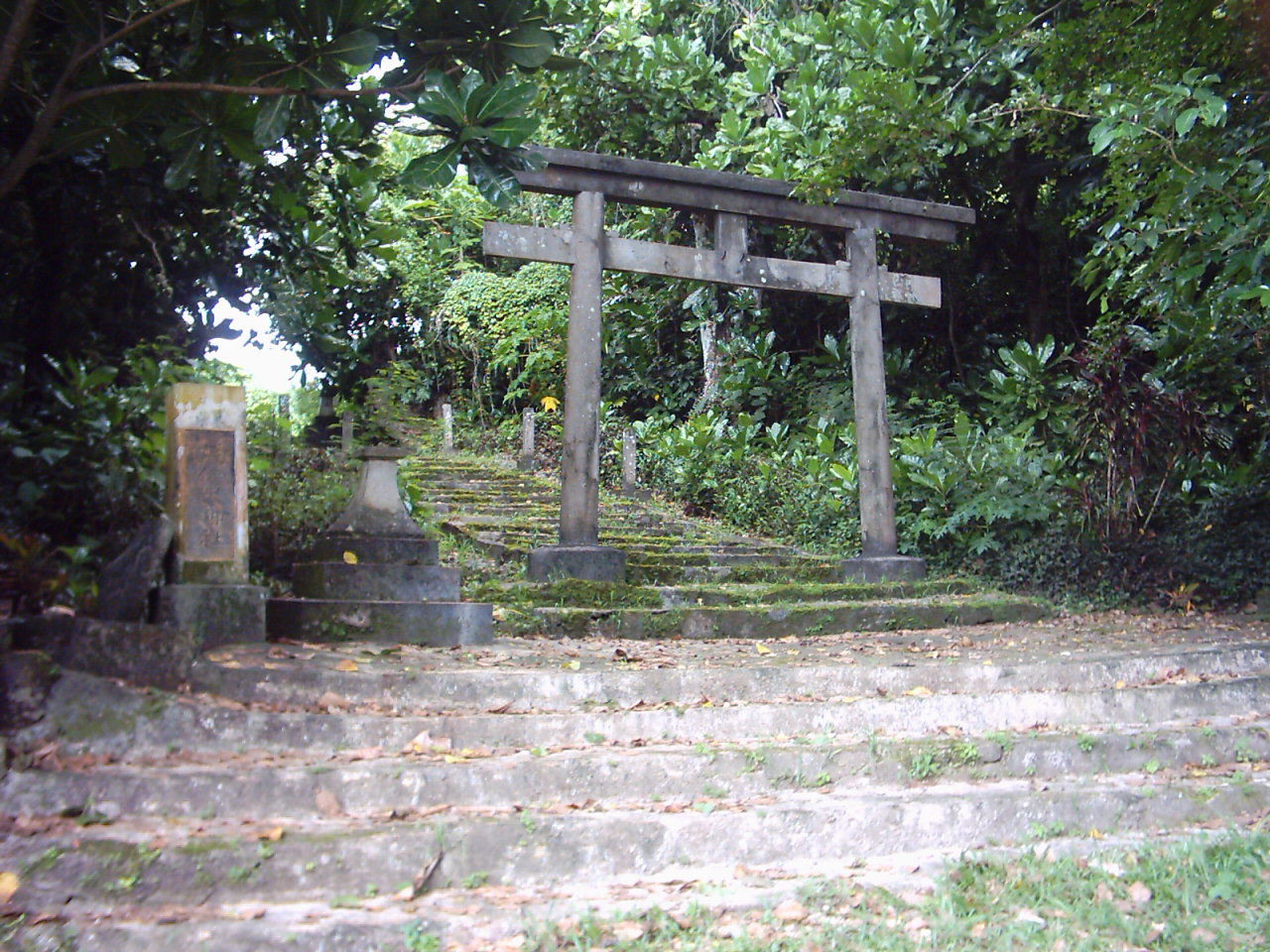 In 1914, during
In 1914, during
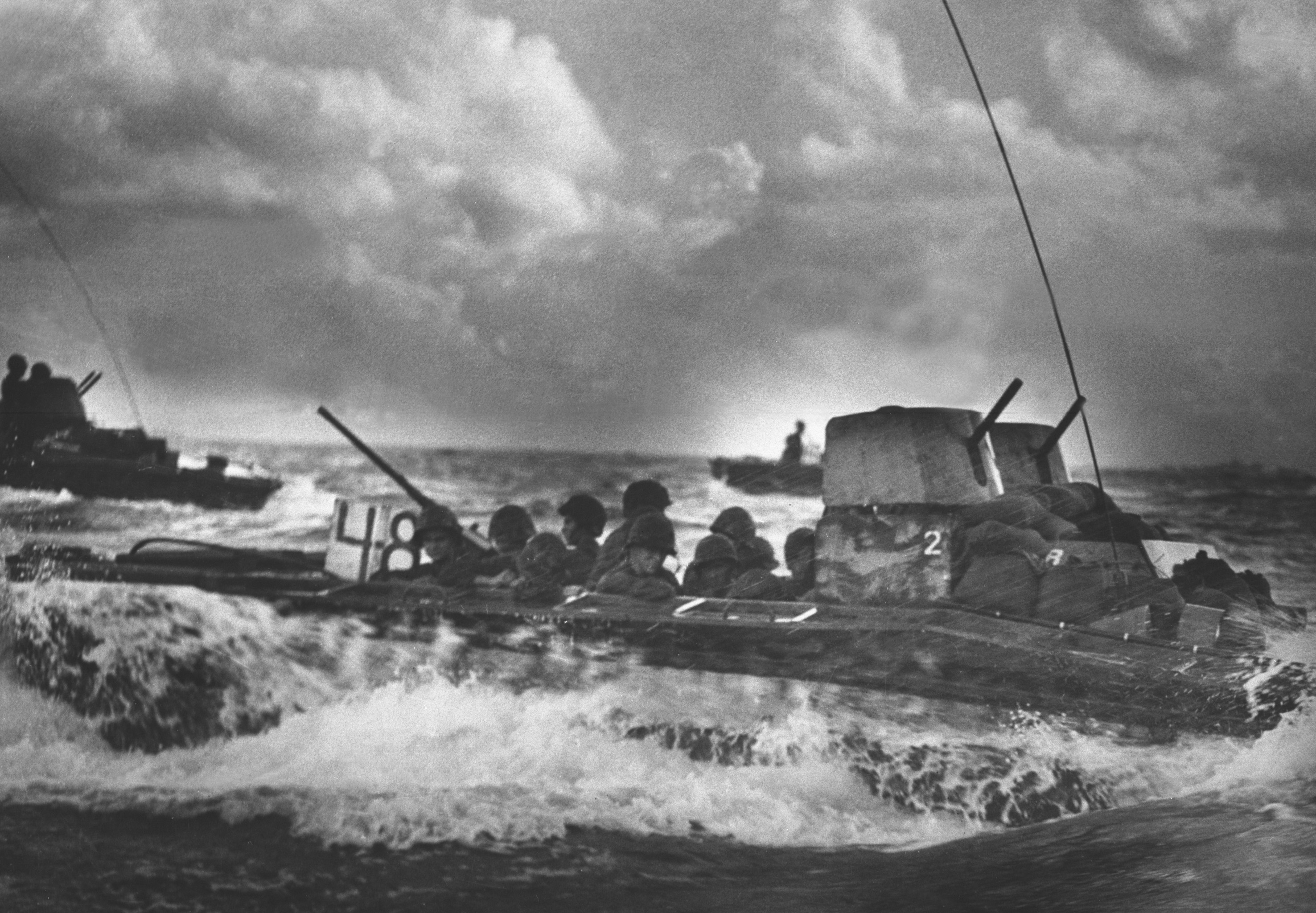
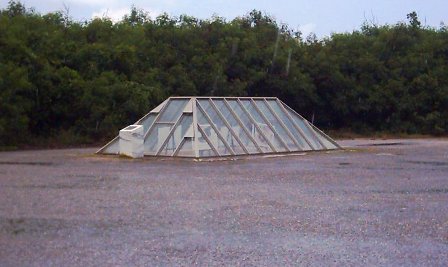 Tinian was not garrisoned by the Japanese military until the latter stages of World War II, when the Japanese realized its strategic importance as a possible base for American Boeing B-29 Superfortress bombers. The island was seized by the Allies of World War II, Allies during the Battle of Tinian from 24 July to 1 August 1944. Of the 8,500-man Japanese garrison, 313 survived the battle. At the time, there were an estimated 15,700 Japanese civilians (including 2700 ethnic Koreans) on the island. Many hundreds were also killed in the crossfire, took their own lives, or were executed by the Japanese military to avoid capture by the Americans.
Tinian is located approximately from mainland Japan, and was suitable as a staging base for continuous heavy bomber attacks on the Japanese Islands. Immediately after the island's seizure by the US, construction began on the largest airbase of WWII, which covered the entire island (except its three highland areas). The Tinian Naval Base was a 40,000-personnel installation, and the Navy Seabee (United States Navy), Seabees (110th NCB) laid out the base in a pattern of city streets resembling New York City's Manhattan Island, and named the streets accordingly.
The former Japanese town of Sunharon was nicknamed "The Village" because its location corresponded to that of Greenwich Village. A large square area between West and North Fields, used primarily for the location of the base hospitals and otherwise left undeveloped, was called Central Park.
Two runway complexes, West Field and North Field, having a combined total of six 8,500-foot (2,600-meter) runways, were constructed. Today the four runways at North Field are overgrown and abandoned. One of the two West Field runways remains in use as part of Tinian International Airport.
Tinian was not garrisoned by the Japanese military until the latter stages of World War II, when the Japanese realized its strategic importance as a possible base for American Boeing B-29 Superfortress bombers. The island was seized by the Allies of World War II, Allies during the Battle of Tinian from 24 July to 1 August 1944. Of the 8,500-man Japanese garrison, 313 survived the battle. At the time, there were an estimated 15,700 Japanese civilians (including 2700 ethnic Koreans) on the island. Many hundreds were also killed in the crossfire, took their own lives, or were executed by the Japanese military to avoid capture by the Americans.
Tinian is located approximately from mainland Japan, and was suitable as a staging base for continuous heavy bomber attacks on the Japanese Islands. Immediately after the island's seizure by the US, construction began on the largest airbase of WWII, which covered the entire island (except its three highland areas). The Tinian Naval Base was a 40,000-personnel installation, and the Navy Seabee (United States Navy), Seabees (110th NCB) laid out the base in a pattern of city streets resembling New York City's Manhattan Island, and named the streets accordingly.
The former Japanese town of Sunharon was nicknamed "The Village" because its location corresponded to that of Greenwich Village. A large square area between West and North Fields, used primarily for the location of the base hospitals and otherwise left undeveloped, was called Central Park.
Two runway complexes, West Field and North Field, having a combined total of six 8,500-foot (2,600-meter) runways, were constructed. Today the four runways at North Field are overgrown and abandoned. One of the two West Field runways remains in use as part of Tinian International Airport.
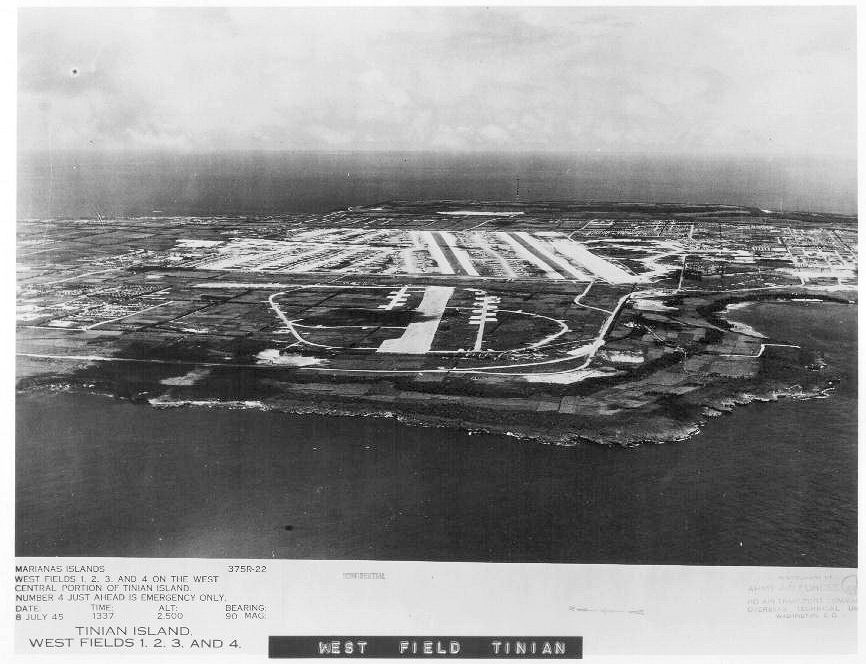 Airfield construction was originally by the Japanese, built with two parallel runways. It was repaired by the Americans, and then called West Field. From here seven squadrons of the 58th Bombardment Wing flew combat and reconnaissance missions throughout Southeast Asia and finally into the Japanese home islands, as part of the bombing of Japan.
After WWII, West Field was Tinian's airport called Gurguan Point Airfield; and today is Tinian International Airport.
Airfield construction was originally by the Japanese, built with two parallel runways. It was repaired by the Americans, and then called West Field. From here seven squadrons of the 58th Bombardment Wing flew combat and reconnaissance missions throughout Southeast Asia and finally into the Japanese home islands, as part of the bombing of Japan.
After WWII, West Field was Tinian's airport called Gurguan Point Airfield; and today is Tinian International Airport.
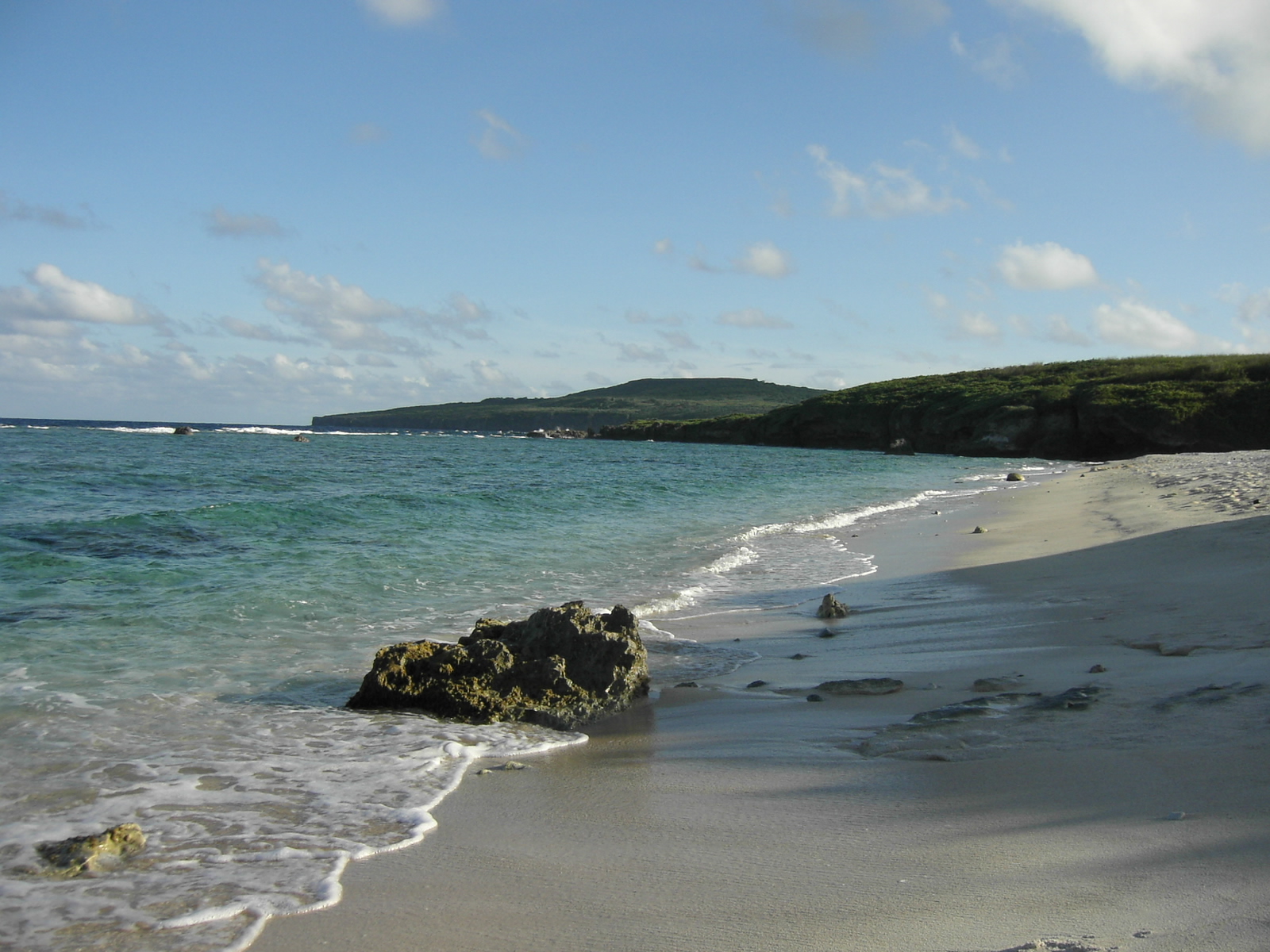
 Tinian is about southwest of Saipan, from which it is separated by the Saipan Channel. It has a land area of , with its highest elevation at Mount Lasso at . It is considerably flatter than Saipan. The island has limestone cliffs and caves. There is a variety of marine life and coral reefs surrounding the island. Its clear, warm waters are ideal for snorkeling, scuba diving and sport fishing.
Tinian is about southwest of Saipan, from which it is separated by the Saipan Channel. It has a land area of , with its highest elevation at Mount Lasso at . It is considerably flatter than Saipan. The island has limestone cliffs and caves. There is a variety of marine life and coral reefs surrounding the island. Its clear, warm waters are ideal for snorkeling, scuba diving and sport fishing.
 The population of Tinian was 3,136 (), which corresponds to less than 5% of all residents of the Northern Mariana Islands and a population density of 31 people per km2. Most of the inhabitants are Chamorros (about 75%) and members of various other groups of islands in the Caroline Islands. There are also minorities of Filipino, Bangladeshi, East Asian and European-descended people.
The population of Tinian was 3,136 (), which corresponds to less than 5% of all residents of the Northern Mariana Islands and a population density of 31 people per km2. Most of the inhabitants are Chamorros (about 75%) and members of various other groups of islands in the Caroline Islands. There are also minorities of Filipino, Bangladeshi, East Asian and European-descended people.
 The House of Taga is a latte stone site, one of the largest such structures in the Marianas. The stones are quarried limestone, each approximately in length. Of the twelve large Latte structures, only one is still standing. The site is one of seven locations on Tinian on the National Register of Historic Places listings in the Northern Mariana Islands.
The House of Taga is a latte stone site, one of the largest such structures in the Marianas. The stones are quarried limestone, each approximately in length. Of the twelve large Latte structures, only one is still standing. The site is one of seven locations on Tinian on the National Register of Historic Places listings in the Northern Mariana Islands.
TINIAN PUBLIC LIBRARY
." State Library of the Commonwealth of the Northern Mariana Islands. Retrieved on January 15, 2017.
''The Insular Empire: America in the Mariana Islands'', PBS documentary film & website
Google Maps
and [https://web.archive.org/web/20140427193501/http://gaebler.info/sonstiges/marianen.htm#tinian Tinian] {{Authority control Tinian, Islands of the Northern Mariana Islands Municipalities of the Northern Mariana Islands Atomic bombings of Hiroshima and Nagasaki Former German colonies Important Bird Areas of the Northern Mariana Islands
Northern Mariana Islands
The Northern Mariana Islands, officially the Commonwealth of the Northern Mariana Islands (CNMI; ch, Sankattan Siha Na Islas Mariånas; cal, Commonwealth Téél Falúw kka Efáng llól Marianas), is an unincorporated territory and commonw ...
. Together with uninhabited neighboring Aguiguan
Aguiguan (also Aguigan and Aguihan, based on the Spanish rendition of the native name, Aguijan, which is still used) is a small bean-shaped coralline island in the Northern Mariana Islands chain in the Pacific Ocean. It is situated south-west of ...
, it forms Tinian Municipality
Tinian Municipality is one of the four constituent municipalities of the Northern Mariana Islands. It consists of the islands of Tinian and Aguijan
Aguiguan (also Aguigan and Aguihan, based on the Spanish rendition of the native name, Aguijan, wh ...
, one of the four constituent municipalities
A municipality is usually a single administrative division having corporate status and powers of self-government or jurisdiction as granted by national and regional laws to which it is subordinate.
The term ''municipality'' may also mean the go ...
of the Northern Marianas. Tinian's largest village is San Jose.
History
Spanish colonial period
Tinian, together with Saipan, was possibly first sighted by Europeans of the Spanish expedition ofFerdinand Magellan
Ferdinand Magellan ( or ; pt, Fernão de Magalhães, ; es, link=no, Fernando de Magallanes, ; 4 February 1480 – 27 April 1521) was a Portuguese explorer. He is best known for having planned and led the 1519 Spanish expedition to the Eas ...
, when it made landfall in the southern Marianas on 6 March 1521. It was likely sighted next by Gonzalo Gómez de Espinosa in 1522 on board the Spanish ship ''Trinidad'', in an attempt to reach Panama
Panama ( , ; es, link=no, Panamá ), officially the Republic of Panama ( es, República de Panamá), is a transcontinental country spanning the southern part of North America and the northern part of South America. It is bordered by Co ...
after the death of Magellan. This would have happened after the sighting of the Maug Islands
Maug (from the Chamorro name for the islands, Ma'ok, meaning "steadfast" or "everlasting") consists of a group of three small uninhabited islands. This island group is part of the Northern Islands Municipality of the Commonwealth of the Northern ...
in between the end of August and end of September. Gonzalo de Vigo deserted in the Maugs from the ''Trinidad'' and in the next four years, living with the Chamorros
The Chamorro people (; also CHamoru) are the indigenous people of the Mariana Islands, politically divided between the United States territory of Guam and the encompassing Commonwealth of the Northern Mariana Islands in Micronesia. Today, signif ...
, visited thirteen main islands in the Marianas and possibly Tinian among them.
The first clear evidence of European arrival was by the Manila galleon
fil, Galyon ng Maynila
, english_name = Manila Galleon
, duration = From 1565 to 1815 (250 years)
, venue = Between Manila and Acapulco
, location = New Spain (Spanish Empire ...
''Santa Margarita'' commanded by Juan Martínez de Guillistegui, that wrecked in the southeast of Saipan in February 1600 and whose survivors stayed for two years till 250 were rescued by the ''Santo Tomas'' and the ''Jesus María''. The Spanish formally occupied Tinian in 1669, with the missionary expedition of Diego Luis de San Vitores who named it ''Buenavista Mariana'' (Goodsight Mariana). From 1670, it became a port of call for Spanish and occasional English, Dutch and French ships as a supply station for food and water.
The native population, estimated at 40,000 at the time of the Spanish arrival, shrank to less than 1400 due to European-introduced diseases and conflicts over land. The survivors were forcibly relocated to Guam
Guam (; ch, Guåhan ) is an organized, unincorporated territory of the United States in the Micronesia subregion of the western Pacific Ocean. It is the westernmost point and territory of the United States (reckoned from the geographic cent ...
in 1720 for better control and assimilation. Under Spanish rule, the island was developed into ranches for raising cattle and pigs, which were used to provision Spanish galleon
Galleons were large, multi-decked sailing ships first used as armed cargo carriers by European states from the 16th to 18th centuries during the age of sail and were the principal vessels drafted for use as warships until the Anglo-Dutch Wa ...
s en route to Mexico
Mexico (Spanish: México), officially the United Mexican States, is a country in the southern portion of North America. It is bordered to the north by the United States; to the south and west by the Pacific Ocean; to the southeast by Guatema ...
.
German colonial period
After theSpanish–American War
, partof = the Philippine Revolution, the decolonization of the Americas, and the Cuban War of Independence
, image = Collage infobox for Spanish-American War.jpg
, image_size = 300px
, caption = (cloc ...
of 1898, Tinian was occupied by the US. It was later sold by Spain to the German Empire in 1899. The island was administered by Germany as part of German New Guinea
German New Guinea (german: Deutsch-Neu-Guinea) consisted of the northeastern part of the island of New Guinea and several nearby island groups and was the first part of the German colonial empire. The mainland part of the territory, called , ...
. During the German period, there was no attempt to develop or settle the island, which remained under the control of its Spanish and mestizo landowners.
Japanese colonial period
World War I
World War I (28 July 1914 11 November 1918), often abbreviated as WWI, was one of the deadliest global conflicts in history. Belligerents included much of Europe, the Russian Empire, the United States, and the Ottoman Empire, with fightin ...
, the island was captured by Japan, which was awarded formal control in 1918 by the League of Nations
The League of Nations (french: link=no, Société des Nations ) was the first worldwide intergovernmental organisation whose principal mission was to maintain world peace. It was founded on 10 January 1920 by the Paris Peace Conference that ...
as part of the South Seas Mandate. The island was settled by ethnic Japanese, Koreans and Okinawa
is a prefecture of Japan. Okinawa Prefecture is the southernmost and westernmost prefecture of Japan, has a population of 1,457,162 (as of 2 February 2020) and a geographic area of 2,281 km2 (880 sq mi).
Naha is the capital and largest city ...
ns, who developed large-scale sugar plantations. Under Japanese rule, extensive infrastructure development occurred, including the construction of port facilities, waterworks, power stations, paved roads and schools, along with entertainment facilities and Shinto shrines. Initial efforts to settle the island met with difficulties, including an infestation of scale insects
Scale insects are small insects of the order Hemiptera, suborder Sternorrhyncha. Of dramatically variable appearance and extreme sexual dimorphism, they comprise the infraorder Coccomorpha which is considered a more convenient grouping than t ...
, followed by a severe drought in 1919. Efforts were resumed under the aegis of the Nanyo Kohatsu Kabushiki Kaisha in 1926, with new settlers from Okinawa as well as Fukushima
may refer to:
Japan
* Fukushima Prefecture, Japanese prefecture
** Fukushima, Fukushima, capital city of Fukushima Prefecture, Japan
***Fukushima University, national university in Japan
*** Fukushima Station (Fukushima) in Fukushima, Fukushim ...
and Yamagata Prefecture
is a prefecture of Japan located in the Tōhoku region of Honshu. Yamagata Prefecture has a population of 1,079,950 (1 June 2019) and has a geographic area of 9,325 km² (3,600 sq mi). Yamagata Prefecture borders Akita Prefecture to the nor ...
s, and the introduction of coffee and cotton as cash crops in addition to sugar, and the construction of a '' Katsuobushi'' processing plant. By June 1944, some 15,700 Japanese civilians resided on Tinian (including 2700 ethnic Koreans and 22 ethnic Chamorro).
World War II
West Field
 Airfield construction was originally by the Japanese, built with two parallel runways. It was repaired by the Americans, and then called West Field. From here seven squadrons of the 58th Bombardment Wing flew combat and reconnaissance missions throughout Southeast Asia and finally into the Japanese home islands, as part of the bombing of Japan.
After WWII, West Field was Tinian's airport called Gurguan Point Airfield; and today is Tinian International Airport.
Airfield construction was originally by the Japanese, built with two parallel runways. It was repaired by the Americans, and then called West Field. From here seven squadrons of the 58th Bombardment Wing flew combat and reconnaissance missions throughout Southeast Asia and finally into the Japanese home islands, as part of the bombing of Japan.
After WWII, West Field was Tinian's airport called Gurguan Point Airfield; and today is Tinian International Airport.
North Field
The Japanese had constructed three small fighter strips on Tinian, but none were suitable for bomber operations. Under the Americans, nearly the entire northern end of the island was occupied by the runways, almost of taxiways and the airfield area, designed to accommodate the entire 313th Bombardment Wing complement of Boeing B-29 Superfortress bombers. North Field was the departure point of the 509th Composite Group specialized ''Silverplate'' nuclear weapons delivery B-29 bombers ''Enola Gay'' and ''Bockscar'', which respectively carried the two atomic bombs named Little Boy and Fat Man, that were Atomic bombings of Hiroshima and Nagasaki, dropped on Hiroshima and Nagasaki. Remains of the US bomber base and Atom Bomb Pits, and the remains of Japanese fortifications, are located at North Field. There is a memorial on the old airfield at the loading pits, which are roofed-over with glazed panels in metal framing for safer viewing. Both pits were reopened in conjunction with the 60th Anniversary Commemoration of the Battle of Saipan, Battles of Saipan and Battle of Tinian, Tinian. The pits were originally constructed to load the bombs, since they were too large to be loaded in the conventional manner. The B-29s were maneuvered over a pit with their bomb bay doors open to facilitate loading.Postwar Tinian
After the end of World War II, Tinian became part of the Trust Territory of the Pacific Islands, controlled by the United States. The island continued to be dominated by the United States military, and until 1962 was administered as a sub-district of Saipan. Since 1978, the island has been a municipality of the Commonwealth of the Northern Mariana Islands. During the 1980s, one of the runways on North Field was kept active to allow U.S. Air Force Lockheed C-130 Hercules, C-130s to take off and land in support of U.S. Marine Corps training exercises in the north end of the island. The two northern airstrips, Alpha and Bravo, were cleared of vegetation and the limestone coral that had been disturbed by roots was excavated and replaced by Marines of the 9th Engineer Support Battalion, 3rd FSSG, 3rd Marine Division then stationed at Camp Hansen, Okinawa in late 1981. That unit had been transported by sea aboard the USS Cayuga (LST-1186). The military presence began to be replaced by tourism in the 1990s, but still plays an important role in the local economy. On October 24, 2018, Typhoon Yutu made landfall on the island of Tinian as a Saffir–Simpson scale#Category 5, Category 5-equivalent super typhoon, becoming the most powerful storm on record to hit the Northern Mariana Islands, and causing an extensive amount of damage.Geography

 Tinian is about southwest of Saipan, from which it is separated by the Saipan Channel. It has a land area of , with its highest elevation at Mount Lasso at . It is considerably flatter than Saipan. The island has limestone cliffs and caves. There is a variety of marine life and coral reefs surrounding the island. Its clear, warm waters are ideal for snorkeling, scuba diving and sport fishing.
Tinian is about southwest of Saipan, from which it is separated by the Saipan Channel. It has a land area of , with its highest elevation at Mount Lasso at . It is considerably flatter than Saipan. The island has limestone cliffs and caves. There is a variety of marine life and coral reefs surrounding the island. Its clear, warm waters are ideal for snorkeling, scuba diving and sport fishing.
Important Bird Area
There is a variety of flora and fauna; the Tinian monarch is the island's only endemic bird species and it is threatened by habitat loss. The island has been recognised as an Important Bird Area (IBA) by BirdLife International because it supports populations of Micronesian megapodes, white-throated ground doves, Mariana fruit doves, Micronesian myzomelas, rufous fantails, Saipan white-eyes and Micronesian starlings.Population
 The population of Tinian was 3,136 (), which corresponds to less than 5% of all residents of the Northern Mariana Islands and a population density of 31 people per km2. Most of the inhabitants are Chamorros (about 75%) and members of various other groups of islands in the Caroline Islands. There are also minorities of Filipino, Bangladeshi, East Asian and European-descended people.
The population of Tinian was 3,136 (), which corresponds to less than 5% of all residents of the Northern Mariana Islands and a population density of 31 people per km2. Most of the inhabitants are Chamorros (about 75%) and members of various other groups of islands in the Caroline Islands. There are also minorities of Filipino, Bangladeshi, East Asian and European-descended people.
Economy
Much of the local economy of Tinian is dependent on tourism, however, tourist infrastructure is relatively poorly developed. The village of San Jose has several smaller hotels, restaurants, and bars. Agriculture is primarily on the subsistence level. The largest employers on the island are the government and the casino, which was legalized in 1989. As of March 2006, the island has plans to put in four new casinos. The 2010 United States Census, 2010 census showed a population of 3,136 for the island.Transportation
Air
Tinian Airport is small and serviced by Star Marianas Air, which operates daily scheduled flights to Saipan. Freedom Air (Guam), Freedom Air, who previously served the island filed for bankruptcy in October 2013 and suspended all operations since March 2014.Ferry
The ferry boat service that operated twice daily between Tinian and Saipan ran at a loss estimated to be US$1 million a year, and has since ceased.Government
The local government is the Municipality of Tinian and Aguiguan, which also includes the uninhabited island Aguijan. The municipality has a land area of 108.1 km2 (41.738 sq mi). The 2000 United States Census, 2000 census population was 3,540 persons, all living on the island of Tinian (Aguijan is uninhabited). The municipal seat and main village of the island of Tinian is San Jose, Northern Mariana Islands, San Jose, situated on the southwest coast. Mayor Edwin P. Aldan was inaugurated in January 2019, succeeding Joey San Nicolas.Local attractions
House of Taga
Education
Commonwealth of the Northern Mariana Islands Public School System operates public schools including Tinian Elementary School, and Tinian Jr./Sr. High School. State Library of the Commonwealth of the Northern Mariana Islands operates the Tinian Public Library in San Jose Village.." State Library of the Commonwealth of the Northern Mariana Islands. Retrieved on January 15, 2017.
References
External links
''The Insular Empire: America in the Mariana Islands'', PBS documentary film & website
Google Maps
and [https://web.archive.org/web/20140427193501/http://gaebler.info/sonstiges/marianen.htm#tinian Tinian] {{Authority control Tinian, Islands of the Northern Mariana Islands Municipalities of the Northern Mariana Islands Atomic bombings of Hiroshima and Nagasaki Former German colonies Important Bird Areas of the Northern Mariana Islands